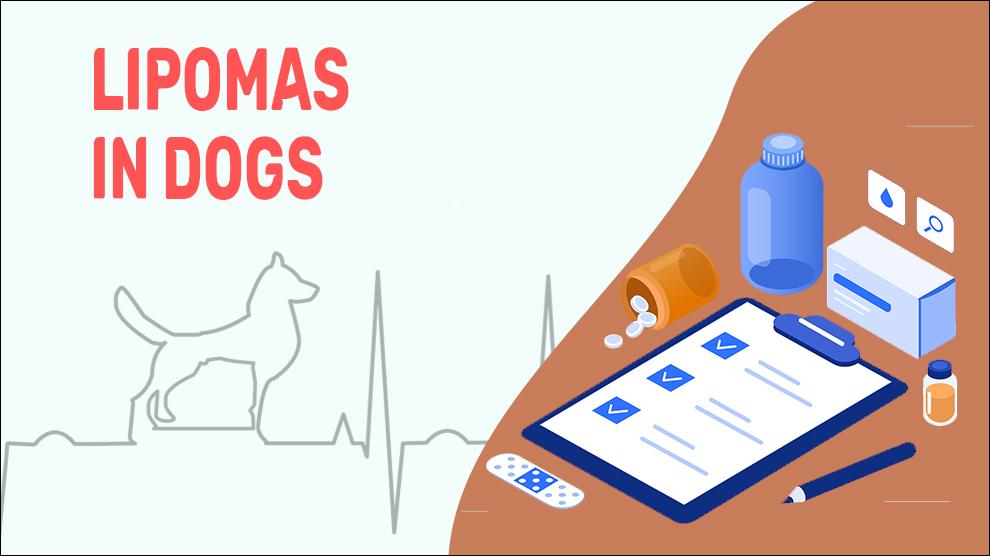What Is Lipomas In Dogs?
Almost all dog owners might have heard of lipomas, or at least their common name, fatty tumors. They are extremely common lumps or masses of fat cells that are often found underneath a dog’s skin.
These masses can be upsetting to pets and pet owners alike.
But, we have some good news. Though lipomas are a common type of tumor, they are usually benign which means they are non-cancerous tumors that are common in overweight dogs.
Medical terms may be confusing, make sure you don’t confuse lipoma with lymphoma. Lymphoma is a malignant tumor of lymph nodes. However, there is also a malignant version of lipoma called a ‘liposarcoma’. A liposarcoma is not a lipoma behaving badly, but it’s an infiltrative tumor arising from lipoblasts.
Lipomas and other fatty tumors are masses of mesenchymal origin, usually a result of improper functioning of the immune and endocrine systems. The body does what it can to encapsulate the substance called the Lipocyte (Adipocyte) and try to get rid of it through the skin. The lumps can be very large depending on how much fat the lipoma stores.
It’s estimated that 16% of dogs are affected by lipomas in their lifetime. It's speculated that neutered and spayed dogs have a somewhat higher risk of developing lipomas.
Symptoms Of Lipomas In Dogs
- Located just under the skin.
- Soft, doughy, and mobile.
- The squishy or fluctuant texture though sometimes firmer in.
- Round, hemispherical or oval, with well-defined borders.
- Most of the time, painless.
Treatment Options For Lipomas In Dogs
In most cases, canine lipomas are harmless and don’t require treatment. Exceptions include if they are large enough or interfere with body functions or hinder normal movement or grow so big that it makes it uncomfortable for your dog to rest or move easily.
If owners elect surgery for cosmetic reasons, most lipomas are easily removed surgically.
Rarely, a lipoma may become injured and infected. Lipomas can’t be drained like a cyst. In those cases, surgical removal is usually the best treatment.
Injectable collagenase to shrink lipomas: e.g. XIAFLEX injections. This is a recent procedure for lipomas (less than 1 inch in diameter) though more research is needed to confirm if these treatments truly work.
Injection lipolysis: An alternative to surgery, an injection is given to dissolve lipomas.
A one-to-one mixture of triamcinolone acetonide (Kenalog) and 1 percent lidocaine (Xylocaine), in a dosage of 10 mg per mL.
Home Remedies For Lipomas In Dogs
Some pet owners advocate for using turmeric (neem oil or flaxseed oil) or homeopathic treatments on lipomas. They have not been clinically tested or proven to eliminate an existing lipoma.
Do not use any home remedies without consulting your veterinarian.
How To Prevent Lipomas In Dogs?
The first step in prevention is to find out if it is a Lipoma or not?
The lipomas are soft, rubbery, painlesslumps; they don’t cause any complications and usually don’t require treatment. However, it is possibly not sufficiently precise to make the diagnosis based on simply running down your hand and feeling how a lump is.
Liposarcomas, a malignant form of lipoma are often confused with lipomas.
A fine needle aspirate (FNA) for lab examination can be easily performed by suctioning some cells from the mass with a syringe. This inexpensive procedure generally provides necessary results. In some cases, if there are any doubts, the sample can be biopsied for accurate results.
Affected Dog Breeds Of Lipomas
Shetland Sheepdog, Dachshund, Cocker Spaniel, Weimaraner, Miniature Schnauzer, Labrador Retriever, Doberman Pinscher, Mix Dog Breeds, Middle Age Dogs, Senior Dogs
Causes And Diagnosis For Lipomas In Dogs
Causes:
Hereditary Lipomas: As with so many other tumors, the exact cause of lipomas is unknown. However, a genetic influence can be assumed because of the over-representation of some breeds of dogs.
Poor Diet: Processed food with additives, chemical preservatives, and other toxins all contribute to fatty tumor growth.
Drugs and Chemicals: Overuse of drugs and chemicals to treat issues like ticks, fleas, heartworm, etc can lead to lipoma growth.
Environment Factors: Pesticides, insecticides, and other toxins.
Morbidity:
Lipomas are benign and they do not metastasize (spread) to other tissues. However, in other ways, they can prove problematic, like when they develop large enough to hamper normal daily activities or when these masses crop up or occupy space in important anatomical locations awkwardly.
Mortality:
There is no documented mortality due to this condition.
Diagnosis:
- Cytology tests
- fine-needle aspirate
- biopsy
Prognosis:
The prognosis for benign and small lipomas is very good. As the existing lipoma doesn’t spread or is life-threatening, no treatment is usually necessary for a lipoma. When the lipoma bothers the dog or is in awkward locations, your vet might recommend it to be excised. Mostly these lipomas are removed for cosmetic reasons and they do not relapse.
When To See A Vet For Lipomas In Dogs?
There are a few malignant tumors, cysts, boils, and goiters that can mimic the rubbery nature of lipoma.
When you notice a rubbery lump on your pet, it is perhaps sensible to show your veterinarian. Most lumps have fairly characteristic texture and need some sort of tissue sampling for diagnosis, while sometimes they can be identified by visual inspection by the vet.
Food Suggestions For Lipomas In Dogs
A well-balanced diet is a precautionary measure for this condition.
- Avoid providing meals that might have fats.
- Omega3 fatty acids- Mackerel, Salmon, Herring, Sardines.
- Lean meats, such as chicken breast, sirloin, or pork.
- Leafy green vegetables, cauliflower, and broccoli.
- Low fat, high protein foods- White-Fleshed Fish, Skinless, White-Meat Poultry, Beans, Peas, and Lentils.
Conclusion
Lipomas are benign and harmless. They do not metastasize (spread) to other tissues. The lipomas are soft, supple, painless lumps; they don’t cause any complications and usually don’t require treatment. Surgical intervention is only required if they are large enough to cause discomfort.

















